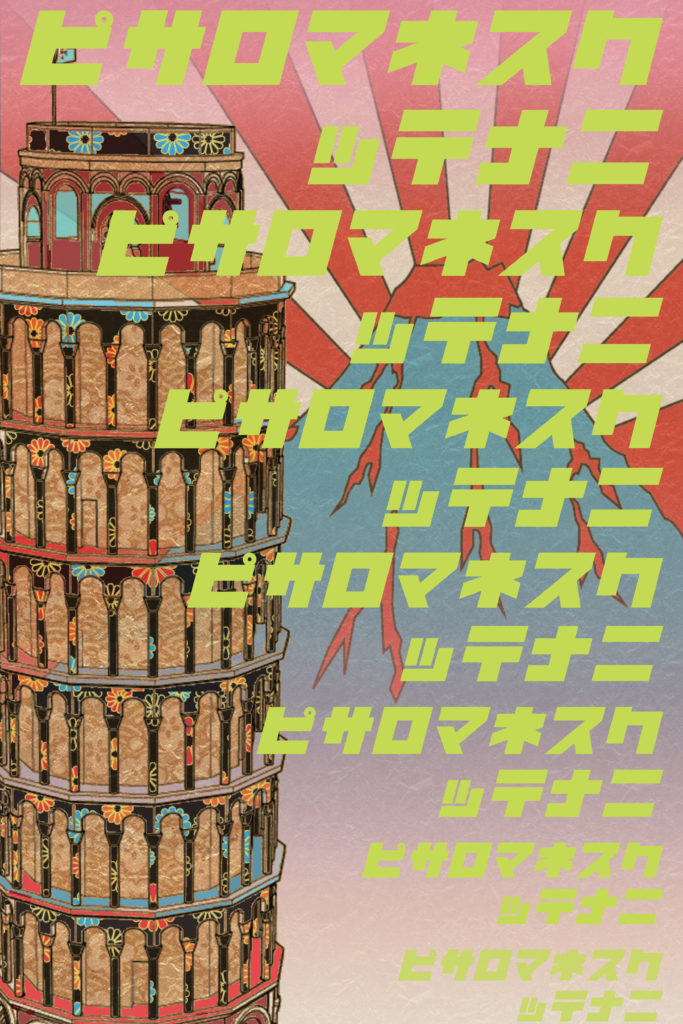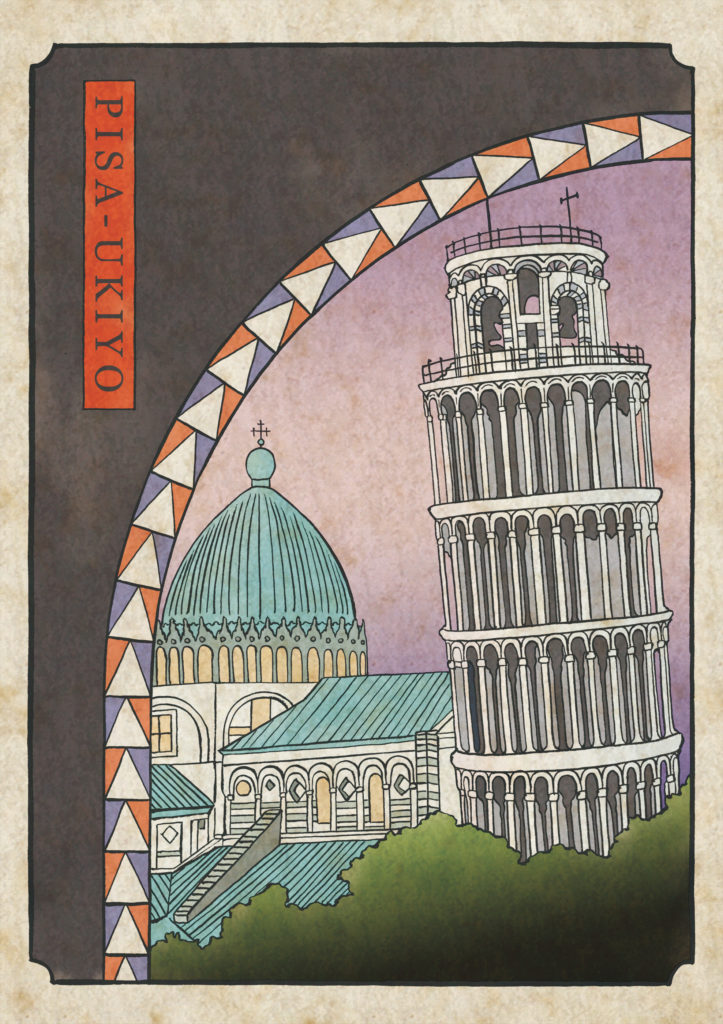winner and honorable mentions
等賞
First prize
Pisa Roman
著者 / Author: 赤津加恵
大学 / School: 桑沢デザイン研究所 / Kuwasawa Design School
教授 / Professor: 豊島晶
作品の媒体 / Medium: ポスター / Poster
作品説明 / Description:
私は日本にピサロマネスク様式の建築の美しさを伝えたいと考えました。そこで日本文化である大正ロマンの特徴のあるテクスチャを使ってピサロマネスク様式の代表的な建物であるピサの斜塔を装飾し、イタリアと日本の架け橋となるポスターを作りました。大正ロマンはもともとヨーロッパから伝わっているので、イタリアと日本の友好関係を表現するのにぴったりだと考えました。ピサの斜塔をdrawingで描いた上からphotoshopで大正ロマンのテクスチャを作り色を塗っています。また、背景に富士山をillustratorで描き、ピサの斜塔と富士山を一つの絵に共存させることによりイタリアと日本の友交を表しました。また日本語特有のカタカナを導入することにより、日本の和を取り入れました。
I wanted to convey to the Japanese the architectural beauty of Pisa Romanesque. So decorated the Leaning Tower of Pisa, which is a typical building of Pisa Romanesque in the picture of a Japanese culture Taisho Roman, made a poster to become a bridge between Italy and Japan. Since the Taisho Roman have been originally introduced from Europe, also to show the friendship relationship with Italy was considered to match. Picture to decorate the Leaning Tower of Pisa is using a texture to all is reminiscent of the Taisho Roman. Italy and the Leaning Tower of Pisa and Mount Fuji draw a Mount Fuji in the background to represent the friend exchange of Japan was allowed to coexist in a single picture. Also I feel the sum of Japan by introducing a Japanese own katakana.
審査委員会からのコメントです。/ Final comment:
この作品は、本コンテストのテーマに沿い制作されたことがうかがえます。
日本とイタリアの文化が近きにあった1930年代の大正時代を背景に、富士山をバックにピサの斜塔が前面に打ち出されたポスターです。
ポスターに使用された角ばった硬い文字フォントも、その時代を思い浮かべさせます。斜塔がまとっている黒地にデザインが施された生地もその時代にあったものを使用し、ディテイルまでこだわりが感じる作品であると評価いたしました。
The artwork depicts very well the theme of the contest, with the making of a poster that sees in the foreground the Leaning Tower of Pisa and Mount Fuji in the background in a style strongly inspired by the Taisho Culture of the Thirties of the Twentieth century, at the time of a strong proximity culture between Japan and Italy. The thematic recall is equally showcased in the writing characters used, with rigid and angular shapes. Work is accurate in every detail and the Tower appears covered with a motif inspired by the Japanese in black fabric of the same time span.
特別賞に
Honorable mention
PISA-UKIYO
著者 / Author: 越谷周平
大学 / School: 桑沢デザイン研究所 / Kuwasawa Design School
教授 / Professor: 豊島晶
作品の媒体 / Medium: グラフィックデザイン /
作品説明 / Description:
私は今回「PISA-UKIYO」というグラフィックを制作致しました。
こちらは日本の絵画表現の一つである「浮世絵」のタッチやイメージを用いてピサの情景を描いた作品です。
制作するにあたり「日本人の私から見たピサの素晴らしさ」というのをテーマに制作していきました。
ピサやロマネスク様式は様々な美しさを持っています。アーチが生み出す優雅さ、淡い色の石材が織りなす華やかさ、近くから見た時の造形の力強さ、そして遠くから見た時では印象が変わる造形の繊細さ。
私はそれらの印象を受け、そしてピサやロマネスク様式には「日本の美」とも共通する部分があるのではないかと考えました。
規則的に並んだ石材で組まれるアーチ状の窓から覗いた先に見えるピサの風景を描きました。
ピサの風景は開放的であり、なおかつ繊細です。浮世絵風に描かれたピサはその絵画表現のタッチに上手く溶け込み、その素晴らしさはより引き出されています。淡い色合いもロマネスク様式、浮世絵、どちらにもマッチしています。
制作工程としては、まず浮世絵の線画を絵の具で描き、それをPCにスキャンしPhotoshopで着色していきました。
浮世絵の古紙を再現するため、Photoshopで古紙風のテクスチャを作り、本物らしく仕上げました。
「日本人の私から見たピサの素晴らしさ」が上手く表現されたグラフィックになっていると思います。
I created a graphic named “PISA-UKIYO”,by using Japanese painting expression method called Ukiyoe. it is a genre style of painting or wood-block printing, developed during the Edo period. It depicts the Japanese landscape and the everyday life of commoners.
During creating this work, I always thought about the wonderful Pisa ,as a Japanese.
Pisa, or romanesque, has various beauties. There are the elegance in an arch, the brilliant color of stone material, the power of shaping that viewing from nearby, and the delicacy of shaping that seeing from a distance. I got the impression from them, and thought that there’re some similarities between romanesque and Japanese beauty.
I painted the landscape of Pisa, by looking from the arched window that the stones are patterned regularly. The landscape of Pisa is open and delicate. Pisa looks more wonderful by using Ukiyoe touches. Light colors also match both romanesque and Ukiyoe.
The process of this work is to paint line drawings firstly, and scan in it to PC. Then, colorize it by using Photoshop.
In order to reproduce old paper, which means , I made texture of it by photoshop. Therefore, my work looks like a real Ukiyoe.
I can say with confidence that this graphic represents well about “the wonderful Pisa ,as a Japanese”.
審査委員会からのコメントです。/ Final comment:
この作品は、江戸時代の浮世絵の手法を使い、ピサの斜塔とドーモをデリケートな彩色で二つの文化の融合を構成した、本コンテストのテーマに沿った作品であると評価いたしました。
The theme of the contest is well centered in this artwork, which has the appearance of prints Ukiyo Edo Era, depicting the Leaning Tower and the Cathedral of Pisa with delicate colors in a refined layout that combines perfectly the two cultures.
特別賞に
Honorable mention
Chopstick case of Leaning Tower of Pisa
著者 / Author: 津田 麻衣子
大学 / School: 桑沢デザイン研究所 / Kuwasawa Design School
教授 /Professor: 豊島 晶
作品の媒体 / Medium: : ペーパークラフト / Paper craft
作品説明 / Description:
箸自体は中国から伝承した文化ですが、木製の割り箸とは、山の多い日本の風土で生まれたものです。
その木製の箸を紙や布で包むというのは、ささやかでありながらも日本人のおもてなしの心を反映した、
大変日本らしい文化だと思います。
また食卓というシーンは、だんらんや交流という側面も持ち合わせており、このシーンを活用したいと考えました。
そのような思いから、ピサ・ロマネスクの文化とおもてなしの文化の融合させた、この斜塔の箸袋を制作しました。
この箸袋ですが、ご覧の通り、ピサの斜塔の特徴的な外観である白い外壁、8層のアーチという要素を取り入れています。
ピサの斜塔は、今日日本に暮らす者で知らぬ人間はいないのでは、と思われるほどにたいへん有名な建築物です。
そのため、ピサ・ロマネスクの文化への取っ掛かりとして、最も適したモチーフだと考え、
今回斜塔をメインモチーフに選びました。
また、ロマネスクの要素の詳細をすべて取り入れるのではなく、あえて少ない要素に絞りこんだデザインにすることにより、
特徴が伝わりやすいよう工夫しています。
制作技法ですが、乳白色のペーパーを使用したペーパークラフトの技法を用いて作成しました。
まず、アーチの美しさが伝わりやすいように、一定の規則性を持たせ、且つ、割り箸がきちんと収まるような
図案を乳白色の紙に書き起こしました。
そして、その図案をひとつひとつカッターナイフで切り抜く、
切り絵のような手法を用いて完成させました。
切り絵的アプローチを選んだのは、切り抜いたアーチの内部に影が落ちることで、自然な厚みが
でると考えたからです。
The disposable chopsticks are the culture that Japan with many forests produced.
I think that it reflects a heart of Japanese おもてなし(omotenasi) to wrap the disposable chopsticks in paper and cloth.
And the scenery called a dining table is a place of the communication.
Using this place, I wanted to spread PisaRomanesque culture.
審査委員会からのコメントです。/ Final comment:
日常的に使用可能な「小物」を、紙と生地を使い図形でピサの斜塔を表現し作られた箸袋で表現した作品です。そして食卓というコミュニケーションには最高の場で、ピサのロマネスク時代の文化を広めるツールとして、実際に商品化することも容易な作品であると評価いたしました。
The theme of the contest is interpreted here to create an object of common use: a container for table chopsticks in paper and fabric that schematically reproduces the Leaning Tower. The object may be easily manufactured and produced as an excellent means of spreading the Pisan Romanesque culture, since the table is an ideal place for communication.


